Page 6 of 402
Table of Contents (cont'd)
Maintenance Schedule Service and Appearance Care
Section
7
Section
6
Scheduled Maintenance
Owner Checks and Services
Periodic Maintenance InspectionsRecommended Fluids and Lubricants
Maintenance Records
Fuel
Checking Fluids and Lubricants
GM Oil Life System™ (If Equipped)
Engine Air Cleaner/Fliter
Passenger Compartment Air Filter (If Equipped)
Brakes
Bulb ReplacementWindshield Wiper Blade Replacement
Tires and Wheels
Appearance Care
Electrical System/Fuses and Circuit Breakers
Capacities and Specifications
Normal Maintenance Replacement Parts
iv
Page 11 of 402
ix
For example,
these symbols
are used on an
original battery:
CAUTION
POSSIBLE
INJURY
PROTECT
EYES BY
SHIELDING
CAUSTIC
BATTERY
ACID COULD
CAUSE
BURNS
AVOID
SPARKS OR
FLAMES
SPARK OR
FLAME
COULD
EXPLODE
BATTERY
These symbols
are important
for you and
your passengers
whenever your
vehicle is
driven:
DOOR LOCK
UNLOCK
FASTEN
SEAT
BELTS
POWER
WINDOW
AIR BAG
These symbols
have to do with
your lamps:
MASTER
LIGHTING
SWITCH
TURN
SIGNALS
PARKING
LAMPS
HAZARD
WARNING
FLASHER
DAYTIME
RUNNING
LAMPS
FOG LAMPS
These symbols
are on some of
your controls:
WINDSHIELD
WIPER
WINDSHIELD
WASHER
WINDSHIELD
DEFROSTER
REAR
WINDOW
DEFOGGER
VENTILATING
FAN
These symbols
are used on
warning and
indicator lights:
ENGINE
COOLANT
TEMP
BATTERY
CHARGING
SYSTEM
BRAKE
COOLANT
ENGINE OIL
PRESSURE
ANTI-LOCK
BRAKES
Here are some
other symbols
you may see:
FUSE
LIGHTER
HORN
SPEAKER
FUEL
Vehicle Symbols
These are some of the symbols you may find on your vehicle.
Page 12 of 402
Service Station Guide
Oil Viscosity
Engine Oil
See Section 6
Engine Oil Dipstick
See Section 6Fuel
Use unleaded gas only,
See Section 6
Cooling System
See Section 5
Hood Release
See Section 6
Windshield Washer
Fluid
See Section 6
Spare Tire Pressure
See Section 5
Alternate
Fuel Door Release
See Section 6
Battery
See Section 6Tire Pressure
See Section 6
For
a More
Detailed Look at
What's Under the Hood
See Section 6
Page 87 of 402
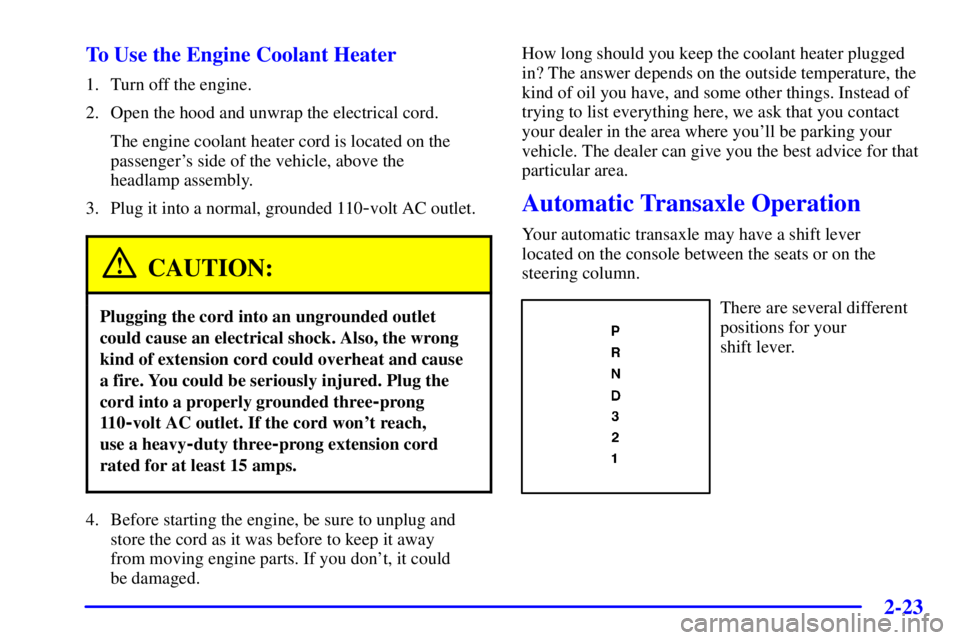
2-23 To Use the Engine Coolant Heater
1. Turn off the engine.
2. Open the hood and unwrap the electrical cord.
The engine coolant heater cord is located on the
passenger's side of the vehicle, above the
headlamp assembly.
3. Plug it into a normal, grounded 110
-volt AC outlet.
CAUTION:
Plugging the cord into an ungrounded outlet
could cause an electrical shock. Also, the wrong
kind of extension cord could overheat and cause
a fire. You could be seriously injured. Plug the
cord into a properly grounded three
-prong
11 0
-volt AC outlet. If the cord won't reach,
use a heavy
-duty three-prong extension cord
rated for at least 15 amps.
4. Before starting the engine, be sure to unplug and
store the cord as it was before to keep it away
from moving engine parts. If you don't, it could
be damaged.How long should you keep the coolant heater plugged
in? The answer depends on the outside temperature, the
kind of oil you have, and some other things. Instead of
trying to list everything here, we ask that you contact
your dealer in the area where you'll be parking your
vehicle. The dealer can give you the best advice for that
particular area.
Automatic Transaxle Operation
Your automatic transaxle may have a shift lever
located on the console between the seats or on the
steering column.
There are several different
positions for your
shift lever.
Page 138 of 402
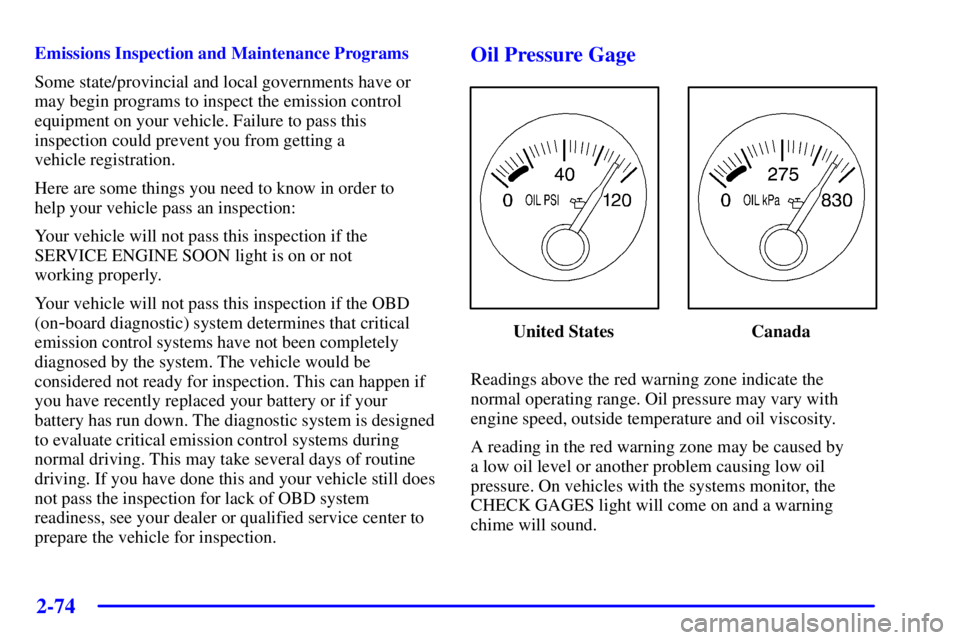
2-74
Emissions Inspection and Maintenance Programs
Some state/provincial and local governments have or
may begin programs to inspect the emission control
equipment on your vehicle. Failure to pass this
inspection could prevent you from getting a
vehicle registration.
Here are some things you need to know in order to
help your vehicle pass an inspection:
Your vehicle will not pass this inspection if the
SERVICE ENGINE SOON light is on or not
working properly.
Your vehicle will not pass this inspection if the OBD
(on
-board diagnostic) system determines that critical
emission control systems have not been completely
diagnosed by the system. The vehicle would be
considered not ready for inspection. This can happen if
you have recently replaced your battery or if your
battery has run down. The diagnostic system is designed
to evaluate critical emission control systems during
normal driving. This may take several days of routine
driving. If you have done this and your vehicle still does
not pass the inspection for lack of OBD system
readiness, see your dealer or qualified service center to
prepare the vehicle for inspection.
Oil Pressure Gage
United States Canada
Readings above the red warning zone indicate the
normal operating range. Oil pressure may vary with
engine speed, outside temperature and oil viscosity.
A reading in the red warning zone may be caused by
a low oil level or another problem causing low oil
pressure. On vehicles with the systems monitor, the
CHECK GAGES light will come on and a warning
chime will sound.
Page 139 of 402
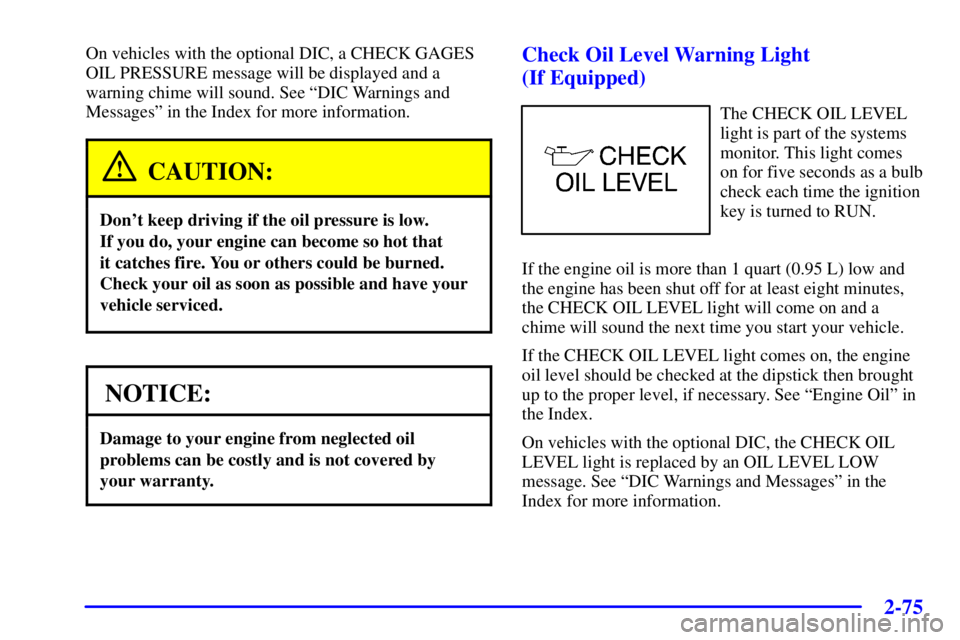
2-75
On vehicles with the optional DIC, a CHECK GAGES
OIL PRESSURE message will be displayed and a
warning chime will sound. See ªDIC Warnings and
Messagesº in the Index for more information.
CAUTION:
Don't keep driving if the oil pressure is low.
If you do, your engine can become so hot that
it catches fire. You or others could be burned.
Check your oil as soon as possible and have your
vehicle serviced.
NOTICE:
Damage to your engine from neglected oil
problems can be costly and is not covered by
your warranty.
Check Oil Level Warning Light
(If Equipped)
The CHECK OIL LEVEL
light is part of the systems
monitor. This light comes
on for five seconds as a bulb
check each time the ignition
key is turned to RUN.
If the engine oil is more than 1 quart (0.95 L) low and
the engine has been shut off for at least eight minutes,
the CHECK OIL LEVEL light will come on and a
chime will sound the next time you start your vehicle.
If the CHECK OIL LEVEL light comes on, the engine
oil level should be checked at the dipstick then brought
up to the proper level, if necessary. See ªEngine Oilº in
the Index.
On vehicles with the optional DIC, the CHECK OIL
LEVEL light is replaced by an OIL LEVEL LOW
message. See ªDIC Warnings and Messagesº in the
Index for more information.
Page 141 of 402
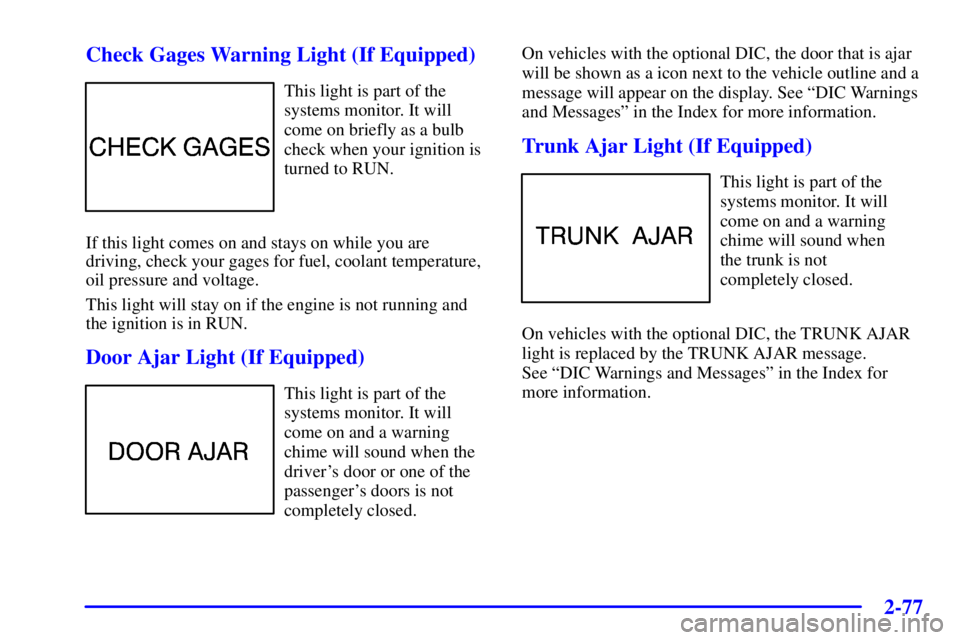
2-77 Check Gages Warning Light (If Equipped)
This light is part of the
systems monitor. It will
come on briefly as a bulb
check when your ignition is
turned to RUN.
If this light comes on and stays on while you are
driving, check your gages for fuel, coolant temperature,
oil pressure and voltage.
This light will stay on if the engine is not running and
the ignition is in RUN.
Door Ajar Light (If Equipped)
This light is part of the
systems monitor. It will
come on and a warning
chime will sound when the
driver's door or one of the
passenger's doors is not
completely closed.On vehicles with the optional DIC, the door that is ajar
will be shown as a icon next to the vehicle outline and a
message will appear on the display. See ªDIC Warnings
and Messagesº in the Index for more information.
Trunk Ajar Light (If Equipped)
This light is part of the
systems monitor. It will
come on and a warning
chime will sound when
the trunk is not
completely closed.
On vehicles with the optional DIC, the TRUNK AJAR
light is replaced by the TRUNK AJAR message.
See ªDIC Warnings and Messagesº in the Index for
more information.
Page 143 of 402
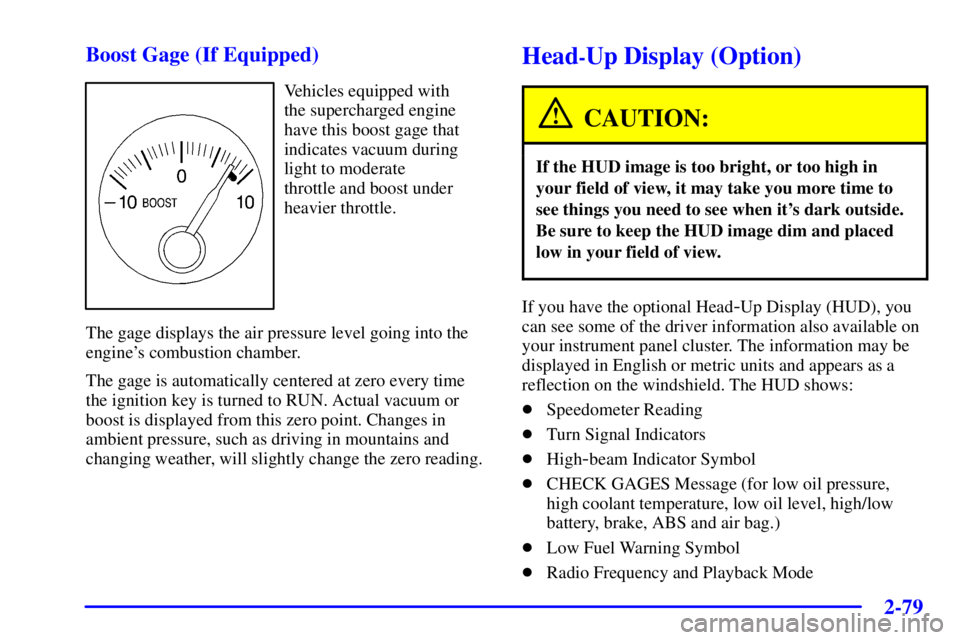
2-79 Boost Gage (If Equipped)
Vehicles equipped with
the supercharged engine
have this boost gage that
indicates vacuum during
light to moderate
throttle and boost under
heavier throttle.
The gage displays the air pressure level going into the
engine's combustion chamber.
The gage is automatically centered at zero every time
the ignition key is turned to RUN. Actual vacuum or
boost is displayed from this zero point. Changes in
ambient pressure, such as driving in mountains and
changing weather, will slightly change the zero reading.
Head-Up Display (Option)
CAUTION:
If the HUD image is too bright, or too high in
your field of view, it may take you more time to
see things you need to see when it's dark outside.
Be sure to keep the HUD image dim and placed
low in your field of view.
If you have the optional Head-Up Display (HUD), you
can see some of the driver information also available on
your instrument panel cluster. The information may be
displayed in English or metric units and appears as a
reflection on the windshield. The HUD shows:
�Speedometer Reading
�Turn Signal Indicators
�High
-beam Indicator Symbol
�CHECK GAGES Message (for low oil pressure,
high coolant temperature, low oil level, high/low
battery, brake, ABS and air bag.)
�Low Fuel Warning Symbol
�Radio Frequency and Playback Mode